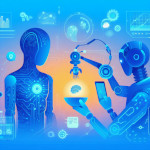
The software industry is undergoing a profound transformation as artificial intelligence (AI) makes its mark on the development process. AI-assisted development is not just hype; it is a real and tangible force that is shaping the future of software creation. In this article, we will explore the transformative impact of AI on software development, delving into how AI is empowering developers, streamlining processes, and revolutionizing the entire software development lifecycle.
Empowering Developers with AI
AI is empowering developers in a multitude of ways, enabling them to work more efficiently, produce higher-quality code, and innovate more effectively. Here are some specific examples of how AI is enhancing developer productivity and expertise:
- Code Completion and Suggestion: AI-powered code completion tools can predict the next code snippet or variable based on the context, saving developers time and effort. These tools can also suggest alternative code structures and optimizations, improving code quality and maintainability.
- Automated Code Generation: AI algorithms can generate code based on natural language descriptions or high-level specifications, alleviating the burden of repetitive coding tasks. This allows developers to focus on more creative and strategic aspects of software design and problem-solving.
- Real-time Code Analysis and Bug Detection: AI-powered code analysis tools can continuously monitor code as it is being written, identifying potential bugs, security vulnerabilities, and performance issues. This real-time feedback helps developers prevent errors early on, reducing the need for debugging and rework.
- Intelligent Testing and Quality Assurance: AI can automate testing tasks, generating test cases, executing tests, and interpreting test results. This automation frees up testers to focus on more complex testing scenarios and exploratory testing, improving overall software quality.
Streamlining Development Processes
AI is not only empowering individual developers but also streamlining the entire software development process, making it more efficient, agile, and adaptable. Here are some specific examples of how AI is transforming development workflows:
- Automated Code Reviews: AI-powered code review tools can automatically analyze code changes, identifying potential issues, recommending improvements, and suggesting alternative approaches. This automation streamlines the code review process, reducing the time and effort required for manual reviews.
- Predictive Maintenance and Anomaly Detection: AI algorithms can analyze software usage patterns, system logs, and performance metrics to detect anomalies and predict potential failures. This proactive approach to maintenance enables developers to address issues before they cause downtime or performance degradation.
- Adaptive Learning and Personalization: AI can personalize the development environment based on individual developer preferences, providing context-aware suggestions, relevant documentation, and tailored debugging assistance. This personalization enhances developer productivity and satisfaction.
- Collaborative AI-Powered Development Platforms: AI-powered development platforms can facilitate collaboration among developers, enabling real-time code sharing, joint debugging, and collective problem-solving. This collaborative approach promotes knowledge sharing and accelerates development cycles.
Revolutionizing the Software Development Lifecycle
AI is not just improving individual aspects of software development; it is transforming the entire software development lifecycle (SDLC), from ideation to deployment and maintenance. Here are some specific examples of how AI is revolutionizing the SDLC:
- AI-Assisted Requirements Gathering and Analysis: AI can analyze natural language requirements documents, stakeholder interviews, and user feedback to extract key requirements, identify potential conflicts, and suggest prioritization strategies. This early AI involvement improves the quality and clarity of requirements, reducing the risk of misunderstandings and rework later in the SDLC.
- AI-Powered Design and Prototyping: AI can assist in conceptual design, generating wireframes, mockups, and interactive prototypes based on design specifications. This rapid prototyping enables early feedback and validation of design concepts, reducing the risk of costly redesigns later on.
- Continuous Optimization and Improvement: AI can continuously monitor software performance, user behavior, and market trends, providing insights for ongoing optimization and improvement. This data-driven approach helps ensure that software remains relevant, competitive, and aligned with user needs.
Conclusion
AI is not just a tool for software development; it is a revolution. AI is empowering developers, streamlining processes, and transforming the entire software development lifecycle. As AI continues to evolve, we can expect to see even more groundbreaking advancements in AI-assisted development, further propelling the software industry into a new era of efficiency, innovation, and productivity.
This article is part of the AI-Assisted Development series and includes other articles, such as:
- Revolutionizing Software Development with AI Assistance: Empowering Developers and Streamlining Processes
- The Ethics of AI-Assisted Development: Ensuring Fairness, Trustworthiness, and Transparency
- AI-Assisted Development for Citizen Developers: Bridging the Gap and Democratizing Software Creation
- AI-Assisted Development in the Enterprise: Fueling Agility, Innovation, and Competitive Advantage
- The Future of AI-Assisted Development: A Vision of Symbiotic Collaboration
